Antigua, the Soul of Guatemala
Article and photos by James
Michael Dorsey
3/2016
|
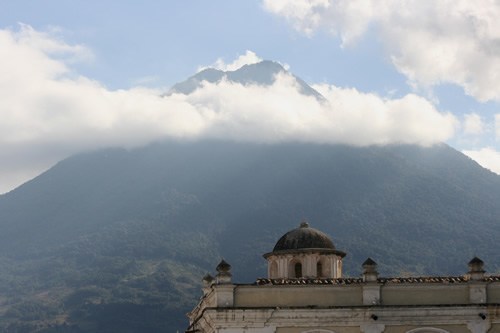
|
|
Volcan de Agua overlooking Antigua.
|
Guatemala's’ Panchow valley trembles from deep below her cobbled streets. On any given day the Volcan de Fuego will vent Sulphur and ash into her sky.
The people of Antigua, true Mayans, will tell you that the tremors are the voices of the spirits that dwell within the three massive volcanoes that surround them like a giant 3-pincered claw.
Antigua is the third incarnation of the former capital city of Guatemala that was founded by Spanish conquistadors and re-located twice due to violent volcanic eruptions. For two centuries it was the military seat of the governor of the “Spanish Colony of Guatemala,” an empire that included most of present day Central America, extending as far north as current Chiapas, Mexico.
The three towering volcanoes that surround the valley are its defining features; the tallest, Acatenango rises to 13,045 feet, (3,976 meters). Volcan de Agua is the most photographed of the three, often framed by colonial doorways, and is called Hunapu by local people as it rises to 12,456 ft. (3,766 meters). Volcan de Fuego, the most active, almost daily spews ash into the cerulean skies, a nonstop reminder of nature’s power, reaches 12,346 feet (3,763 meters). The city of Antigua, an aging symbol of colonial domination, has become one of the country’s main tourist draws, rivaling the visitor numbers of the more famous ruins at Tikal, Yaxha, and Topoxte.
Now an UNESCO World Heritage Site, the city has survived floods, earthquakes, and volcanic eruptions since its founding in 1543, and remains a premier example of Spanish baroque architecture; an aging dowager refusing to reveal herself without her makeup, and a beautiful sight to behold. Antigua has long been a center of religious learning since Franciscan monks settled the valley in the mid 16th century, followed by Jesuits and Dominicans, all of whom built magnificent ornate cathedrals, the many ruins of which punctuate its cobbled streets. Antigua is the royal dame of colonial cities, and its ethereal beauty has been featured in numerous films and videos.
|
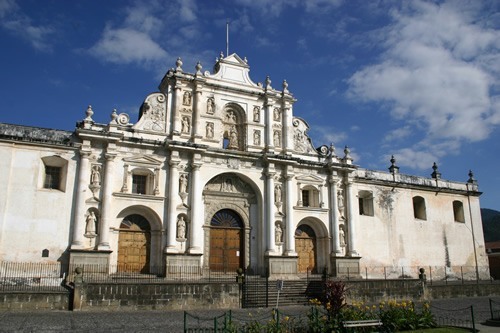
|
|
A colonial church in Antigua.
|
Perhaps the supreme allure of the city is the Sunday afternoon market when local time reverts to earlier days. Kapchikel Mayans, the local indigenous clans, descend from their mountain homes to share their textile handiworks with the hordes of visitors who have come specifically to witness the history and pageantry of the event. The city transforms to a living time capsule as raven-haired artisans set up their looms and spread their world-renowned textiles out for sale, turning entire streets into riots of color. These are not farmers bringing crops or livestock to market, but artisans of the highest order. The work of these artisans is the equal of museum collections, and you can watch them creating in real time. The Mayans weave textiles gracefully as birds fly. Antigua’s market attracts buyers from around the globe.
|
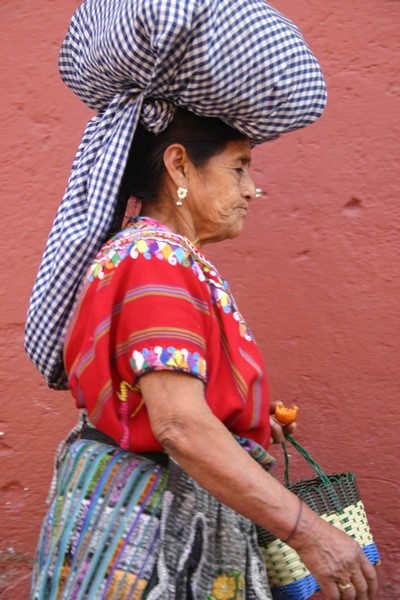
|
|
A market vendor.
|
|
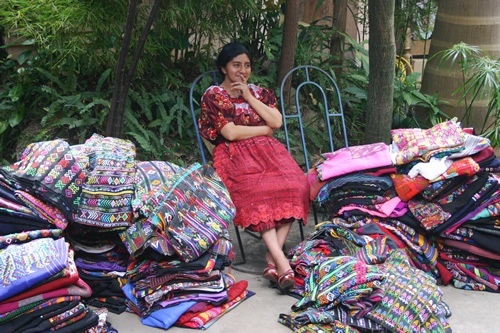
|
|
A local artisan selling her textiles.
|
At first light on market day, colorful, hand painted buses — themselves mobile works of art — begin shuttling both locals and tourists into the central square where the entire day seems to have stopped in the mid 16th century. During these brief respites from the day-to-day the old world merges with the new, giving tourists a glimpse at an ancient and proud people living a ritual as they have for centuries. Market day is a chance for modern Guatemala to meet its earlier self, but also seems to end far too quickly. The mountain people begin to fade back into the highlands with the setting sun, allowing the outer world only this elusive moment of contact, which perhaps intentionally serves to maintain the unique local Mayan identity and mystique.
|
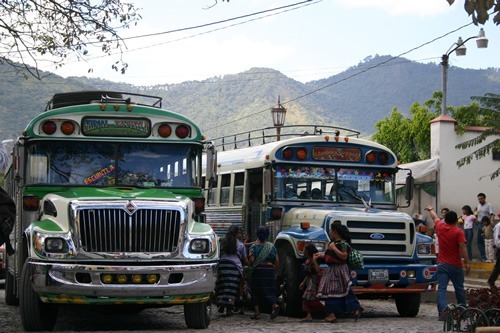
|
|
Colorful public buses in Antigua.
|
Children play and splash about in the central fountain, whose statue of mother earth spills the water of life from her exposed breasts. Nearby women as colorfully attired as songbirds hand beat their laundry in the clear waters of the public square as tourists surround them with cameras. Barefoot or sandaled women negotiate the uneven cobblestones with wicker baskets of clothing perfectly balanced on their heads. Children chase each other through back alleys wearing masks of the devil that are such an integral part of local folklore.
|
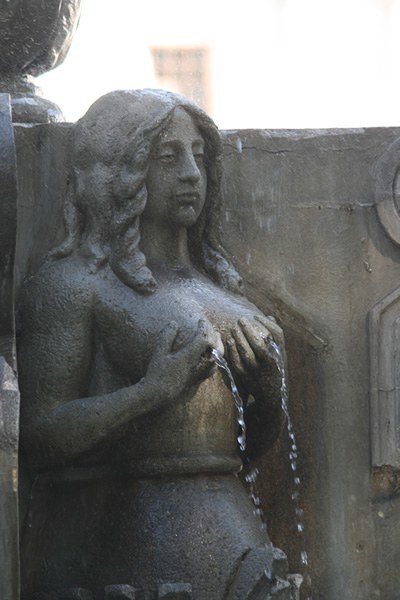
|
|
Mother Earth fountain in Antigua.
|
Perhaps the most popular destination in the city is the hotel Casa Santa Domingo that began life as a Dominican monastery in 1538. It was a massive edifice for its day, with twin towers and ten bronze bells. The corridors were filled with colonial treasures, many of which can be found in the rooms of the hotel that occupies its ruins today. The modern hotel is built amidst the sagging ruins and merges both the flavor of the old world with the technology of the new. The hotel has become both the historical and artistic centerpiece of the city. Visitors to its aging corridors can visit both a colonial and archeological museum, plus pre-Columbian art, silver, and pharmacological museums. Besides being the most popular destination in town for weddings, it is the most comprehensive archive of city's history. On the hotel steps you can usually find several textile weavers still using old world hand looms.
Antigua is a deeply Catholic city that stages a massive procession through the streets each year to announce the beginning of Lent as well as the holy days leading up to Easter. Masks, both religious and profane, are traditional accessories to the costumes pilgrims don to proclaim their penance. If you listen closely you may still hear some of the ancient tongues being spoken by leathery-faced elders who still live in the old ways of the surrounding mountain villages. On market day the city becomes colonial Spain. Yet this is a colony that is as yet undefeated. The majesty and dignity of the indigenous people is on full public display. If you follow the people into their mountains, Jaguars still stalk the land and Coatimundis are as common as field mice. These friendly little creatures that resemble a cross between a raccoon and badger may walk right up to you in the city, and locals treat them as fellow citizens. Blue Herons soar over her fertile rivers and crocodiles too numerous to count populate the waterways they share with subsistence fishermen.
|
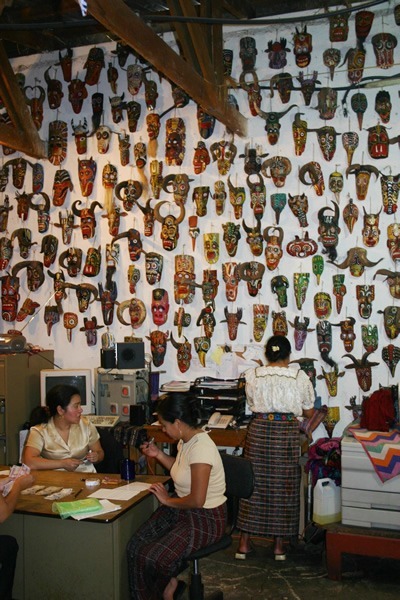
|
|
Wall of masks.
|
Antigua is only a 45-minute drive from the capital, Guatemala City, and there is daily bus service between them with multiple departures going both ways. Any local cab driver with happily take you there for a modest fare. The city is an aging gem far enough away to not be overrun by tourists, yet close enough for the curious to learn about her many secrets.
James Michael Dorsey is
an explorer, award winning author, photographer, and
lecturer. He has traveled extensively in 45 countries,
mostly far off the beaten path. His main pursuit
is visiting remote tribal cultures in Asia
and Africa.
|
